Exploring Care for Children with Autism in Wales Using Creative Writing as a Research Method in a Collaborative Pilot Study
Kate North describes a recent project conducted by the Autism Collaborative Research Group (ACRe), that utilizes writing workshops to capture the experiences of clinicians, educators and parents of children with Autistic Spectrum Disorder (ASD) in South Wales.
Abstract
This article comes out of a recent project conducted by the Autism Collaborative Research Group (ACRe), using writing workshops to capture the experiences of clinicians, educators and parents of children with Autistic Spectrum Disorder (ASD) of the ASD care pathways in South Wales. ACRe is an interdisciplinary group comprised of six researchers across a range of subject areas (creative writing, healthcare, psychology, logistics, education and mathematics) who are interested in the use of interdisciplinary research methods to explore autism care.
Key words: creative writing, workshop, poetry, narrative medicine, interdisciplinary, research method, autism, care pathway, health, education
HOW TO CITE THIS ARTICLE
North, Kate. (2017) Exploring Care for Children with Autism in Wales Using Creative Writing as a Research Method in a Collaborative Pilot Study. Writing in Practice. 3 DOI: 10.62959/WIP-03-2017-06
Background
As a writer of poetry and fiction I am interested in the capabilities of writing to enable people to explore what is hidden, obscured or unacknowledged through the practice of the craft. Writing has long been understood as a process with such uses by writers and creative writing researchers. As Jane Hirshfield acknowledges (2008: 23), through a mediation of outward data of the world and the words of the poem we can begin to understand the truth that “resides in us”. Not only can we reach new understandings of subjects through writing, we can also use writing to shed light on complicated scenarios and environments. In their discussion of creative writing as research Jeri Kroll and Graeme Harper describe writing as something that helps to “illuminate” complex interrelationships (2013: 2). When considering my own writing practice I find myself in agreement with these expressions. When I write I do so to tell a story, to express a truth, to communicate an idea. Yet I also write to understand that which I am writing about, to explore and consider my subject from new perspectives. Sometimes I will make a discovery about the subject of my writing through the act of writing itself. I use the writing process to explore and understand the subject matter of my text and I often make unexpected discoveries or realizations. When writing I am interested in the end product, the text, the utterance: but also in the process that takes me to the destination. Through this process my understanding of a theme or subject can develop and evolve. Sometimes, years after the writing of a story or a poem, when rereading it I will uncover a new understanding of its meaning. The text becomes a marker of a moment, of a time, that can live on and be re-understood from future perspectives. As Denzin posits, writing is a way of making the world visible, it is a method of discovery and analysis (2014: 569).
There are researchers in other fields who have realized that creative writing is also a useful method of discovery and analysis beyond the arts and humanities. Such a researcher, in a recent paper on epidemiological research, claims that:
The narrative technique called ‘storytelling’ is currently on the rise. Storytelling uses information about experiences and actions of people and communities, to visualize and capture, beyond the statistics, the meaning embodied within the data. (Cofiño et al 2014).
Data needs to be captured and interpreted in order for meaning to be garnered from it. Cofiño acknowledges that storytelling is a process that manages to provide interpretation beyond statistical representation. In the context of this project, I wanted to see if creative writing could be used to capture data about ASD care pathways and also to help interpret it. As ASD care for young people has a variety of stakeholders I was interested to find out whether creative writing exercises with a range of the stakeholders could collect data that could be examined empirically and critically but could also be used to voice meaning in and of itself. I wanted to understand whether creative writing exercises with stakeholder participant groups could be used as a source of empirical data while simultaneously providing an interpretation of the reality of ASD care pathways in contemporary Wales.
It is these uses and outcomes of creative writing that I hoped to employ when entering into the research project that is the subject of this paper.
Context
The Welsh Government (WG) established a Strategic Action Plan (SAP) to meet the needs of individuals with ASD and their families in 2008. In this document it was acknowledged that ASDs pose challenges that are “multi-faceted and complex” (2008: 3) and that “because of the nature of ASD, people fall into the gaps between services”. The SAP also asserted that “effective co-operation” between services and agencies was required. The ACRe collaborative study was established in order to explore stakeholders’ experiences of care pathways in the wake of the SAP. In 2015 WG announced a review of the ASD SAP and this study, with creative writing practice at its core, was used to generate findings that enabled ACRe to feed into the review. The study has also resulted in findings that demonstrate the need for the work of ACRe to continue beyond this initial small-scale exploration.
Three sessions were held in which focus groups and writing workshops were conducted with participants. While the use of focus groups is a recently established method in social science research (Bryman 2012: 501), the use of creative writing as a research method in health and education contexts has been increasing over the last decade. Through this mixed approach we wanted to explore the information garnered from each method and consider its usefulness in terms of attesting to the success of the SAP. In addition to this we wanted to compare the information gathered from each method in a number of ways. Firstly a literal comparison would consider the similarities and differences of the information acquired from each approach. Then, through close textual analysis we would compare the modes of expression drawn from across each method along with the subsequent benefits and complications they related about the SAP and ASD care pathways. Finally, we would also undertake a mathematic consideration of the language used by participants across both methods through statistical analysis for further enhanced investigation.
While I have outlined, in general terms, why I feel creative writing is useful in interdisciplinary research, it is worth explaining exactly why ACRe felt it could be suitably employed in this particular research study. ASD is a broad spectrum and the range of care needs for those experiencing ASD are similarly broad. For example, while one person experiencing ASD may be high functioning and undiagnosed with no perceived care needs, another may be diagnosed as low functioning with significant clinical and education support needs identified. And then, of course, there is the range of people who are situated between these extreme ends of the spectrum. Some with educational needs only, others with clinical needs. That is before one even considers the amount of people awaiting diagnosis and who may or may not have specific needs. The pathways involved in care provision sit across the clinical and education sectors, making delivery logistically complex and communication between sectors essential. Given the breadth of ASD experience and the variety of stakeholders associated with ASD care (educators, clinicians, those experiencing ASD and their families), the complexity of providing appropriate care or of conducting meaningful research in the field is evident. In view of this complexity, ACRe researchers considered that a collaborative approach in this area could potentially generate new and meaningful perspectives from which the SAP review and future care provision planning may benefit. The writing workshop is by its very nature a forum that is suitable for collaboration and the voicing of multiple perspectives. There is a steadily growing body of research suggesting that story telling as a means of communicating illness is a worthwhile activity in diagnostic and treatment terms. Healthcare professionals understand that to impart knowledge is also to improve care (Peterkin 2011). Sociologists have discussed the usefulness of exploring “illness narratives” as a means to “throw light on disrupted experience, its meanings and actions taken to deal with it” (Bury 2001). ACRe became interested in the possibility that stakeholder narratives could be used to explore the effectiveness of ASD care pathways. Creative writing workshops could be designed to generate narratives that may possibly impart knowledge, which in turn could be used to improve care.
Medical applications of writing practice in diagnosis, therapy, education and research have been asserted as beneficial because of the framework they can offer clinicians for approaching patient problems holistically (Greenhalgh & Hurwitz 1999). Where a patient narrative is provided it may uncover options in terms of therapy and diagnosis. Furthermore, narrative can also be viewed as a method that addresses more existential and less empirical experiences of feelings and emotions such as grief, pain, hope and hurt. Greenhalgh and Hurwitz have argued that the “lost tradition” of handing down myths and legends through generations by word of mouth in Western culture may have something to do with the lack of recognition for listening and interpretation as clinical skills in medical training. They, and many others cited in this paper, have begun to establish various inroads for use of narrative in many aspects of medicine. In the relatively new field of narrative medicine the power of narrative to “make audible” and “power radical change” in healthcare (Charon 2009) has been recognized and it has been established that “experiencing and treating sickness are language-using events” (Charon & Sayantani 2011).
The uses of “poetic inquiry” and the application of “ethnographic poetic representation” as a method have also developed in interdisciplinary research (Rapport & Harthill 2010). The research poem is now identified as “a powerful tool to highlight emotion and magnify lived experience” (Furman 2015) in the social sciences and beyond, while writing poetry in qualitative research has been used to “provide cultural insight” of a particular group or population (McCulliss 2013) in multidisciplinary projects. As someone who writes both poems and stories I was interested in the application of these forms in differing interdisciplinary contexts. I was also intrigued to learn more about the differences and similarities between using these different forms of creative writing in health and social science research. I could see potential benefits and challenges in choosing either form as a focus for the creative writing workshops. A story writing workshop could sound fairly daunting to people new to the experience of a writing workshop.However, it may be easier to locate the notion of story writing and story telling in a more accessible social context, for instance through the blockbuster movie’s reliance on the hero’s journey as a model of narrative structure. Poetry may be seen as something more digestible and possible to produce in a short workshop, owing to the brevity of the form, yet it has also been perceived to be an exclusive and elitist form of “high art”, as Huyssen notes (1986: 163). I decided that I wanted to utilize both forms in the writing workshop so that I could ascertain whether one was more suitable for this type of research than the other.
No previous research into autism care pathways has been conducted using creative writing. Nor has any research that explores the effectiveness of the co-operation between services and agencies providing ASD care pathways in the UK been undertaken. While this was a small-scale pilot project initial findings have already provided the crucible for further research in the areas of ASD care pathways and creative writing as a method for collaborative research.
The ACRe pilot project sessions each had between six and eight participants. The first session was held in a mainstream junior school that also had an attached specialist ASD class. Participants were all education professionals: two mainstream teachers, two Additional Learning Needs (ALN) teachers, the Head Teacher, a Teaching Assistant and the Deputy Head Teacher, who was also the school ALN Co-ordinator. In addition to this there was a Speech and Language Therapist, who was not an education professional but had a longstanding association with the school. She described herself as often working to help bridge the gap in care provision between the education and clinical services. The second session was held in the same school with a group of parents of children with ASD who attended the school in mainstream and specialist classes. Their children ranged from low to high functioning, undiagnosed, newly diagnosed and long-term diagnosed. The third session was with clinicians at a Child and Adolescent Mental Health Services centre. The group included a Consultant Clinical Psychologist, a Speech and Language Therapist, three Consultant Child and Adolescent Psychiatrists (2 Tier Two – targeted, 1 Tier Three – specialist) and an Occupational Therapist. The decision not to collect specific data relating to the age and ethnicity of participants was made because such data is not pertinent to the parameters of the study being conducted.
We had also initially wanted to run a group comprised of children with ASD. However, given the scale of the project we found this impossible to organize. The variables would be too large, as we would have to make decisions around age, ability and position on the spectrum. To incorporate ASD children in any meaningful way we would most likely need more than one group of participants. A larger amount of time than was available would be needed to construct sessions that would enable participants with large variations in ability to partake in an equitable and meaningful manner. The SAP states that those experiencing ASD should be heard and their opinions considered when organizing care pathways. ACRe hope to undertake a more inclusive study in future, larger scale projects.
Planning and Delivery
Each of the sessions ran in the same manner over the course of one day. The first part of the session was devoted to a focus group in which participants discussed their own experiences of ASD care. This was followed by them constructing a “typical” ASD care pathway as organized from participant responses based on their own experience. The “typical” care pathway we knew would be a generalization as, given the complexities of the spectrum and the liaison with different agencies, it is clear that each person’s journey through care is individual to them. However, it was hoped that the creation of a “typical” pathway would give each group a representative model to discuss. It would also give the research team a composite model of each group’s experiences. After constructing the “typical” pathway participants were then given a short break with refreshments and time to talk informally about their experiences.
The second part of the session was devoted to a writing workshop in which participants completed three writing exercises devised especially for the project. One exercise was poetry focused and the other two exercises related to narrative, plot and story telling. The sessions were also audio recorded to ensure the veracity of information for purposes of recall and analysis. In addition to this the sessions were visually recorded by an illustrator. The visual illustrator produced images that attempted to draw together information gathered from the sessions in an accessible format.
The writing exercises were designed to enable participants to write about their professional and/or personal experience of ASD care in a creative manner. They were also designed to be as accessible as possible in terms of the level of literacy required to complete them, since the groups were extremely varied in their make up. Previous writing experience and levels of literacy were impossible to standardize or ascertain, particularly with regard to the parent group, before the sessions were held. While certain presumptions about levels of literacy could be predicted with the clinical and education professionals, owing to the nature of their qualifications and day-to-day jobs, it could not be assumed that parents would have the same range of abilities. In addition to this, I did not know how willing people would be to engage in the creative writing workshop; there was no way of anticipating the participants’ creative competency across all of the groups. Participants had merely been told that a group of academics conducting research into ASD care pathways in South Wales were looking for willing volunteers to share their experiences. Participants had not explicitly signed up for a creative writing session and I was anticipating the possibility of resistance, confusion, embarrassment or reluctance to share creatively.
When constructing the exercises I considered how participants might be best encouraged to relate their experiences in a creative yet relatively simple and swift manner. Given the complexities of ASD care pathways as outlined earlier, I thought it reasonable to reckon that participants might be able to understand their experiences in terms of the traditional hero journey. The first writing exercise I designed related to plot and narrative structure (Propp 1969). Participants were asked to consider themselves as the hero protagonists in their narratives. They were tasked with organizing their lived experiences into goals and obstacles. Finally, participants considered what sort of “helper” could assist them in reaching their goals.
The second exercise was framed around a poetic inquiry. I had read much of the benefits of narrative practice (Charon 2006) and of poetic inquiry (Rapport & Harthill 2012). I was keen to compare the use of both in the project. The poetry exercise focused on the creation of an image. Participants were asked to identify their most frustrating or insurmountable obstacle from the previous exercise. They were then asked to describe this obstacle through sensory details, which were used to create a series of figurative images representing the obstacles.
The third exercise returned to narrative and involved participants writing a very short story. An exemplar was provided as a trigger, the six word story often attributed to Ernest Hemmingway (Haglund, 2013), “For Sale: Baby shoes, never worn”. Participants then wrote their own very short story outlining their imagined “ideal” experience of ASD care. The story was broken down into three sections: a beginning that set up a goal; a middle that stated how obstacles would be overcome for the goal to be achieved; and an ideal ending or outcome. Each section was to be written in two to five words, ensuring that the final story was no longer than fifteen words in total.
While most participants were quite curious about partaking in a creative writing workshop, a few were particularly enthusiastic and a few were decidedly not. Nevertheless, all entered into the workshop with application. I spent some time explaining why we thought creative writing would help with our research and this did appear to mitigate concern if not entirely convince all participants. After each exercise participants were invited to share what they had written. Not all participants did so but one or two did on each occasion. As the participants had already spent some time discussing their experiences together in the focus group session, people felt comfortable enough to share their stories. The levels of comfort were akin to, from my own personal experience, those levels achieved after the second or third session of a new writing workshop in an educational or community session. After the sessions had finished one particularly sceptical participant came to tell me that she had totally changed her mind. She was a senior clinician with a large workload and weighty responsibilities, someone who would not take time out from her day-to-day clinical commitments lightly. She stated that she could see the value in asking clinicians to reflect on their practice creatively, giving them new ways to communicate and understand their experience. She made these comments after initially paying the writing exercises only cursory attention.
Findings
Some very clear information came from the creative writing exercises. From the initial exercise on plot there were consistent messages from each of the groups in terms of their ideal “helpers” (Propp 1969). Parents wanted “one point of contact” throughout their care pathway who could work with the various agencies and the complex bureaucracy of dealing with multiple sectors and professionals. Teachers wanted someone to bridge the gap between agencies in terms of “support” and to organize “provision”, whereas the clinicians wanted administrative support and “pathways” to communicate between agencies. One of the striking elements was that they all wanted help liaising between the different systems but each group described this in markedly different terms.
One practical way in which to demonstrate this within the confines of this paper is to utilize word clouds generated from the words used by the participant groups through the creative writing exercises. The word clouds from exercise one are constructed from words that appeared two or more times in each of the exercises within groups. Where a child’s name occurred this has been substituted with the word “son”.
Parents Exercise 1

Clear themes that come from this exercise understandably demonstrate the child being at the centre of parents’ concerns relating to their goals, but it is also apparent that they see the “school” and the need to be understood as being strongly connected to achieving their goal.
The results from the teachers exercise show “children” as being prominent in terms of the their goal.
Teachers Exercise 1
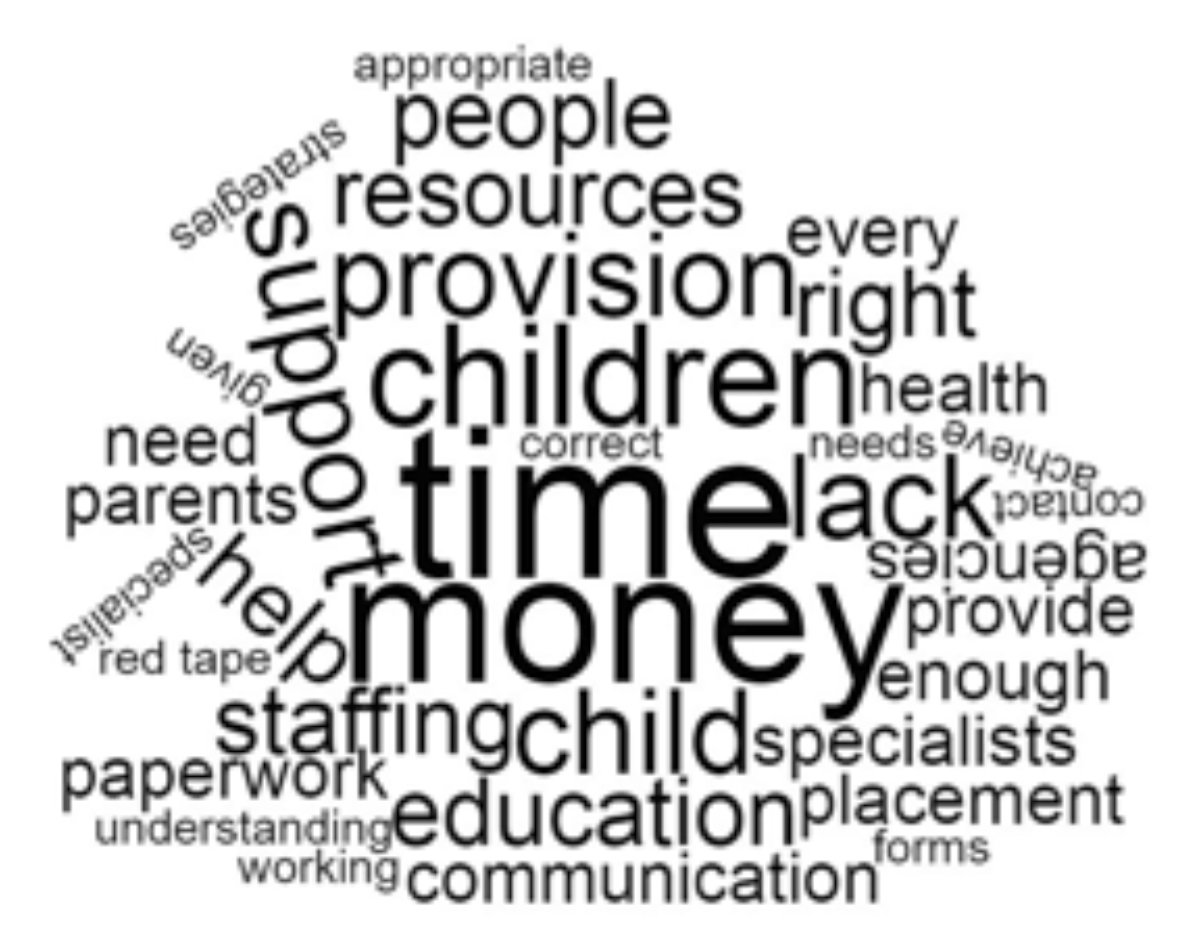
However, more prominence is given to the words “time” and “money”, suggesting a consistent issue for teachers across these areas. The teachers’ and parents’ clouds have occurrences of words that relate either in equivalent terms such as ”parents” and “teachers” or as repetitions such as “education” giving the impression that the educational environment and facilities are deemed as being of central importance to achieving the goals of the stakeholders.
While “education” appeared in the clinicians’ word cloud there is no reference to “school(s)”, “teachers”, “parents” or “children”.
Clinicians Exercise 1
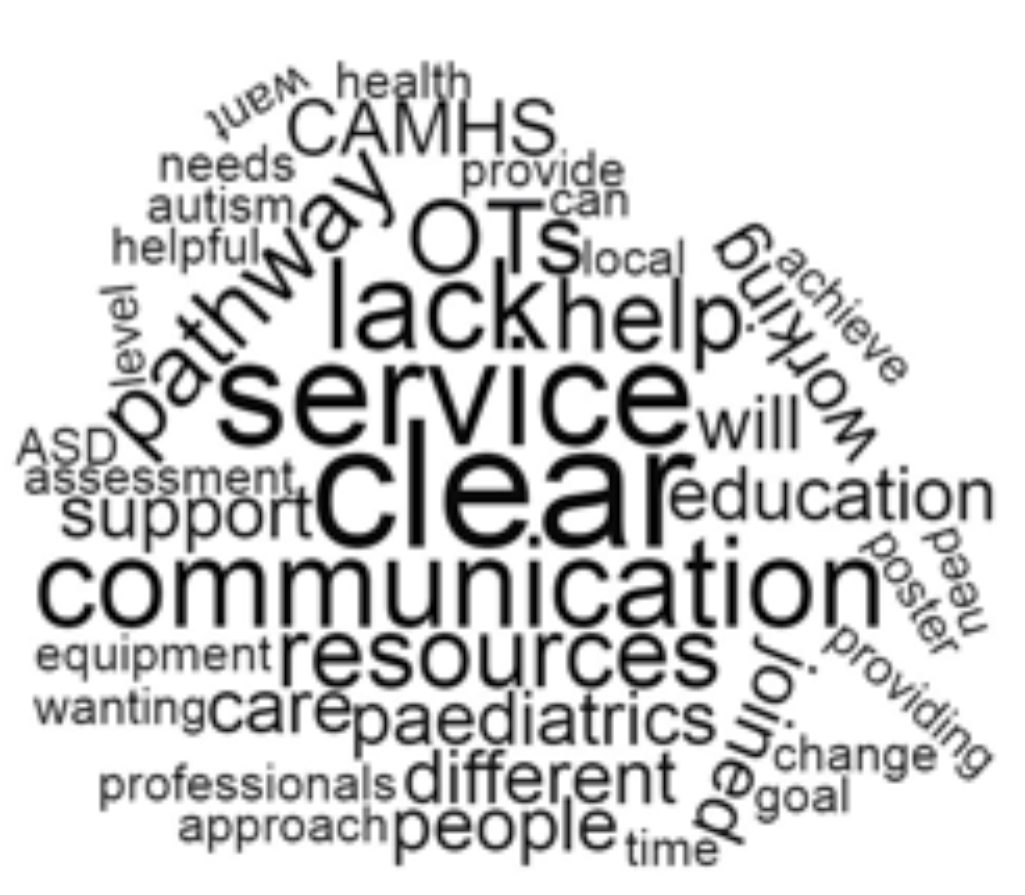
The word with the most prominence is “clear”, and unlike the other two clouds, no reference to individuals or groups of people is found among the higher occurring words. Groups of people appear with lower occurrence: “professionals” and “OTs”. While the prominence of “communication” and “resources” echoes some of the teachers’ words there are a large number of words that do not appear in either of the other two clouds. Many of these can be understood as clinically related, such as “service”, “paediatrics”, “OTs” and “CAMHS”. The last two are acronyms for Occupational Therapist and Child and Adolescent Mental Health Services. While the pilot study is in no way large enough to produce conclusive findings it is interesting that the teachers’ and parents’ clouds appear to share more in common while the clinicians’ cloud stands alone to a greater degree. There are obvious practical factors that could lie behind this difference, the main one being that children attend school five days a week whereas clinicians do not see children so regularly. As a result, much of the identified need for care and support for children with ASD – certainly its perceived need by parents and teachers – would seemingly need to take place within the school environment. Regardless of this factor the clinicians’ word clouds could be seen to indicate that there is some separation between them and the other groups in terms of expectations and experiences relating to goals – and the language used to describe those goals. All three word clouds contain the words “support”, “communication”, “resources”, “lack” and “need”, demonstrating some consistent themes across groups.
From the image construction exercise there was greater consistency across the groups. All groups cultivated many images that conveyed notions of pain (biting, banging, the screech of nails down a blackboard, car horn) and impotent frustration (wading through treacle, brick wall, bottomless pit). While the exercise did generate some useful information I feel it was the least successful of the three. Given the time I had to run the workshop I feel it would have been more sensible to focus exclusively on prose or poetry. While I had intended to make a comparison between the success of approaching each form I found that this was over ambitious, given the time available. The poetry exercise got squeezed in terms of time limits and the work produced was the least formed or crafted. The images created were very interesting in their similarity across groups but I would have liked to have been able to develop this exercise, in order that participants might have time to create entire poems, either as individuals or in groups.
The word clouds for exercises two and three contain all of the words generated in the exercises. The image generation exercise appears to have evoked some synergy in the responses across groups.
Parents Exercise 2
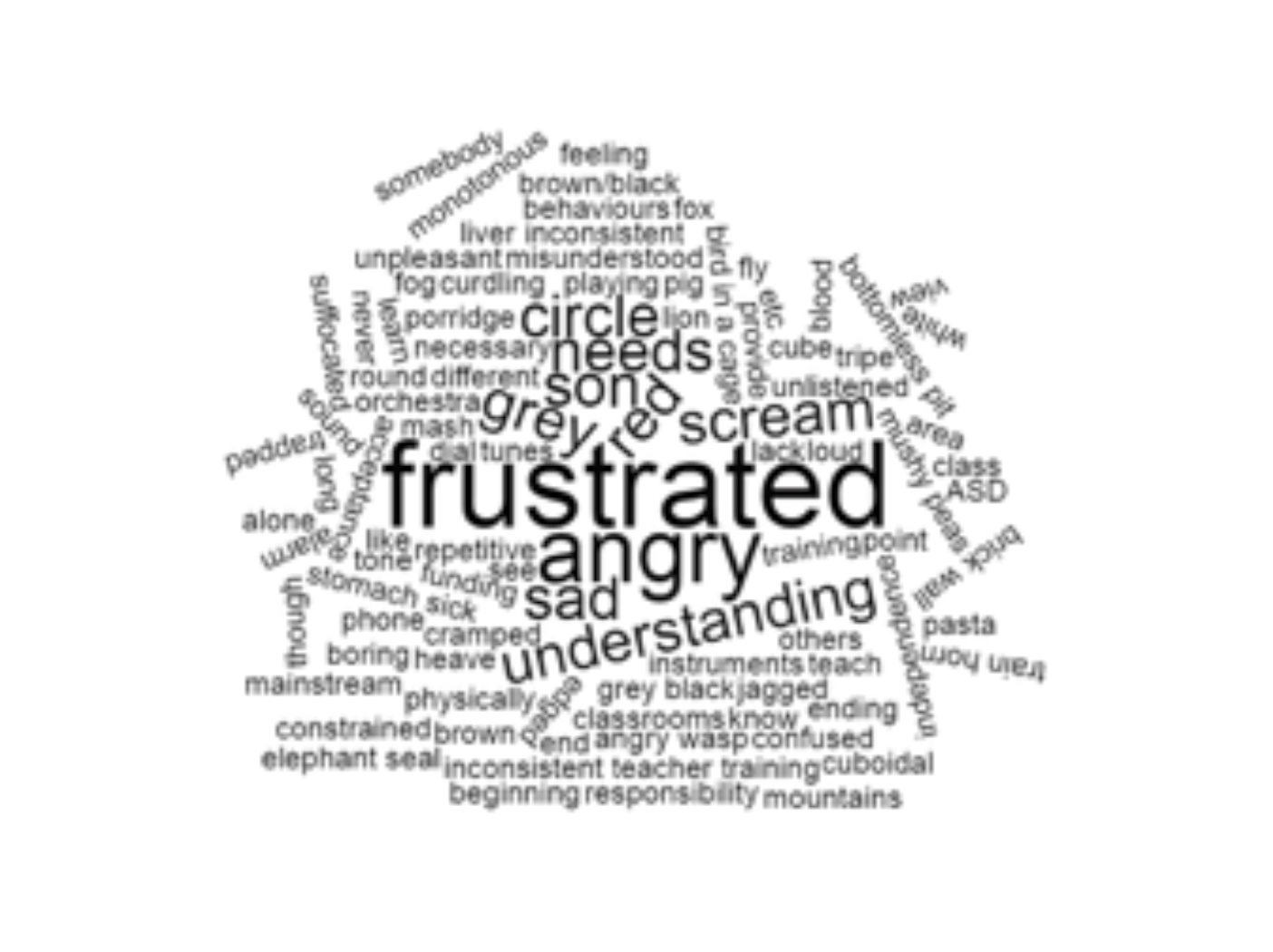
The biggest word is “frustrated” and this was given in response to a question about how the most significant obstacle in the way of participants’ goals made them feel. This word appeared with prominence across all word clouds, as did the word “grey”, which was used by participants to describe their obstacles. The teachers’ word cloud for exercise two again bears similarities with the parents’.
Teachers Exercise 2

Not only are “frustrated” and “grey” present but the word “need” chimes with the parents’ word “needs”. Also, there is reference again to “people”, echoing the personal relevance to lives that can be understood from the parents’ word “sons”. Interestingly, the clinicians’ second word cloud gave no prominence to the people at the centre of the care pathway in their response.
Clinicians Exercise 2
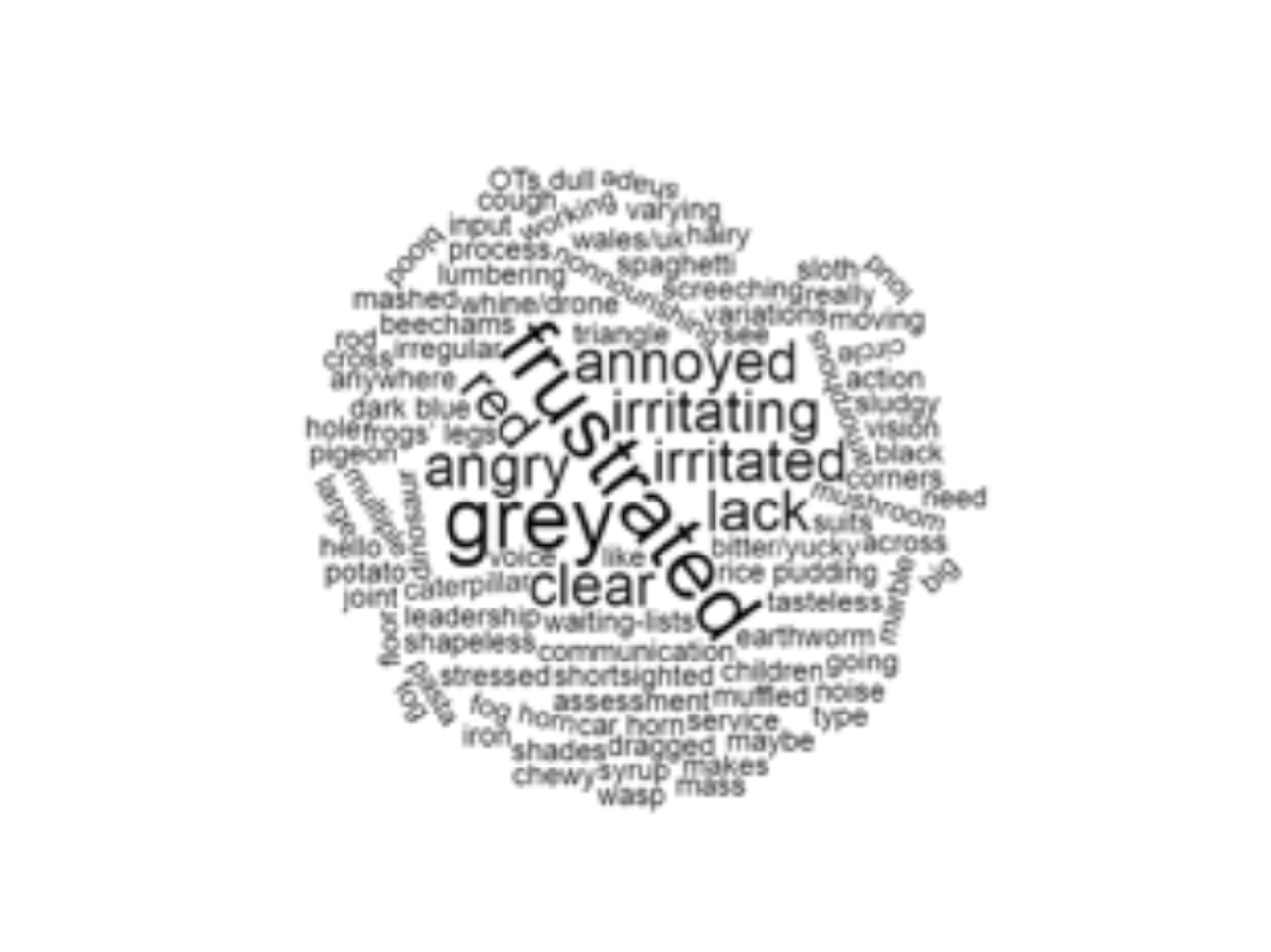
The clinicians’ word cloud did chime with the parents’ word cloud in terms of the prominence of “angry” and “red”. The word “lack” could also be read in relation to the parents’ and teachers’ use of “need(s)”.
The short story exercise generated an interesting crossover of goals and ideal outcomes for each group. All three groups wrote about wanting to “support” and to achieve “happiness” and “independence” for children with ASD. Teachers specifically wrote about fulfilling “potential”, clinicians wanted an “efficient” and “effective” service, and parents wrote of “awareness” and “positive” outcomes. So again, while there were unifying themes and objectives, there was also evidence of considerable differences in the language used to communicate them across groups.
When looking at the third exercise through the prism of a word cloud there is further constancy with some of the synergies already identified between groups.
Parents Exercise 3
The short story exercise asked participants write about their vision of an ideal ASD care pathway experience. Here is one short story from a parent:
“Dreams of American freight trains. Travels, watches, learns, asks questions. Grows up, drives that train.”
This poignant story demonstrates the very personal desires and ambitions the parent has for their child’s happiness. This is something that was broadly demonstrated when looking at all of the stories together though word clouds.
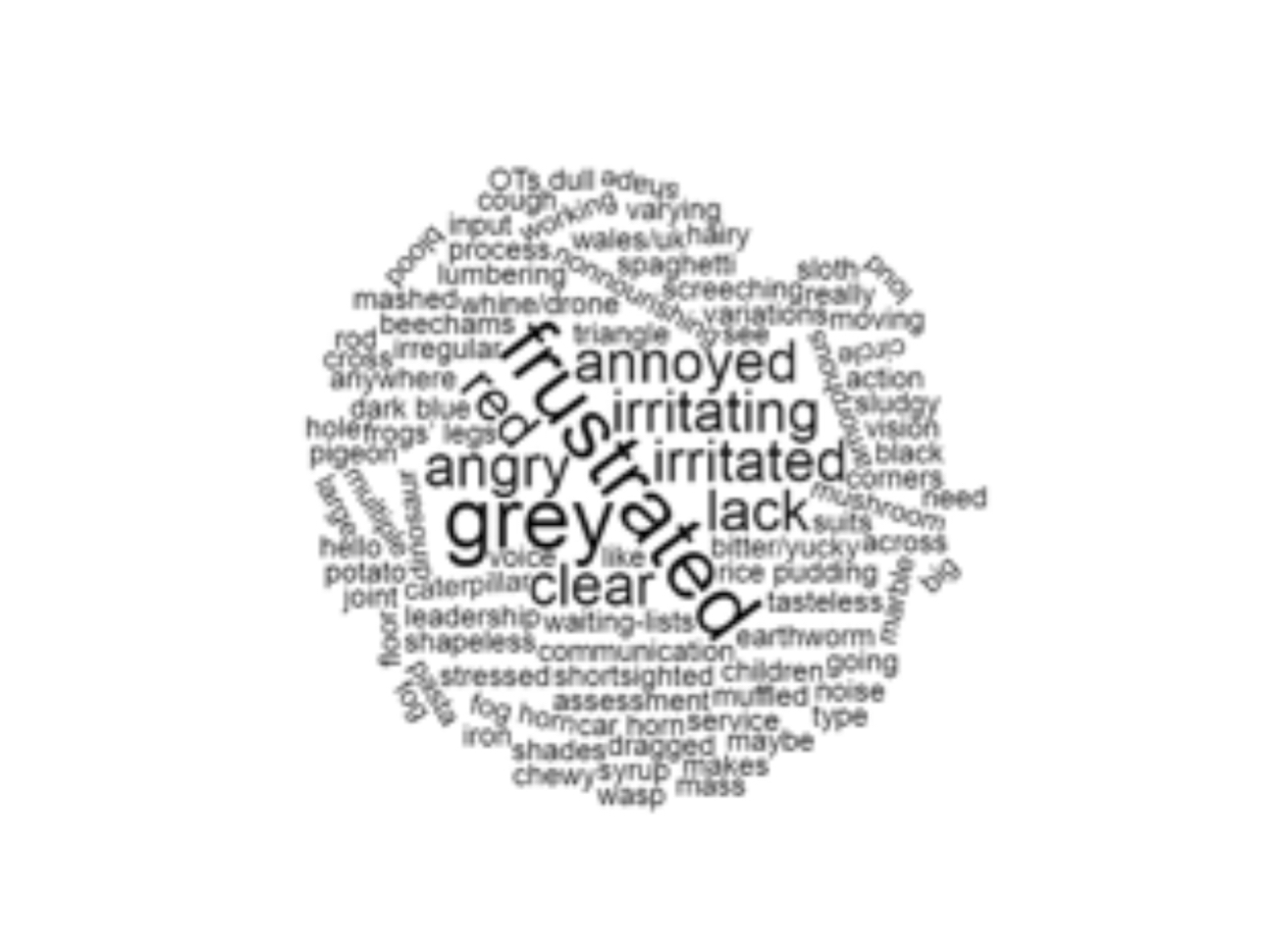
When looking at the word cloud, “happy” is clearly the most used word and there is reference again to persons at the centre of the pathway. This was reiterated by the teachers.
Teachers Exercise 3
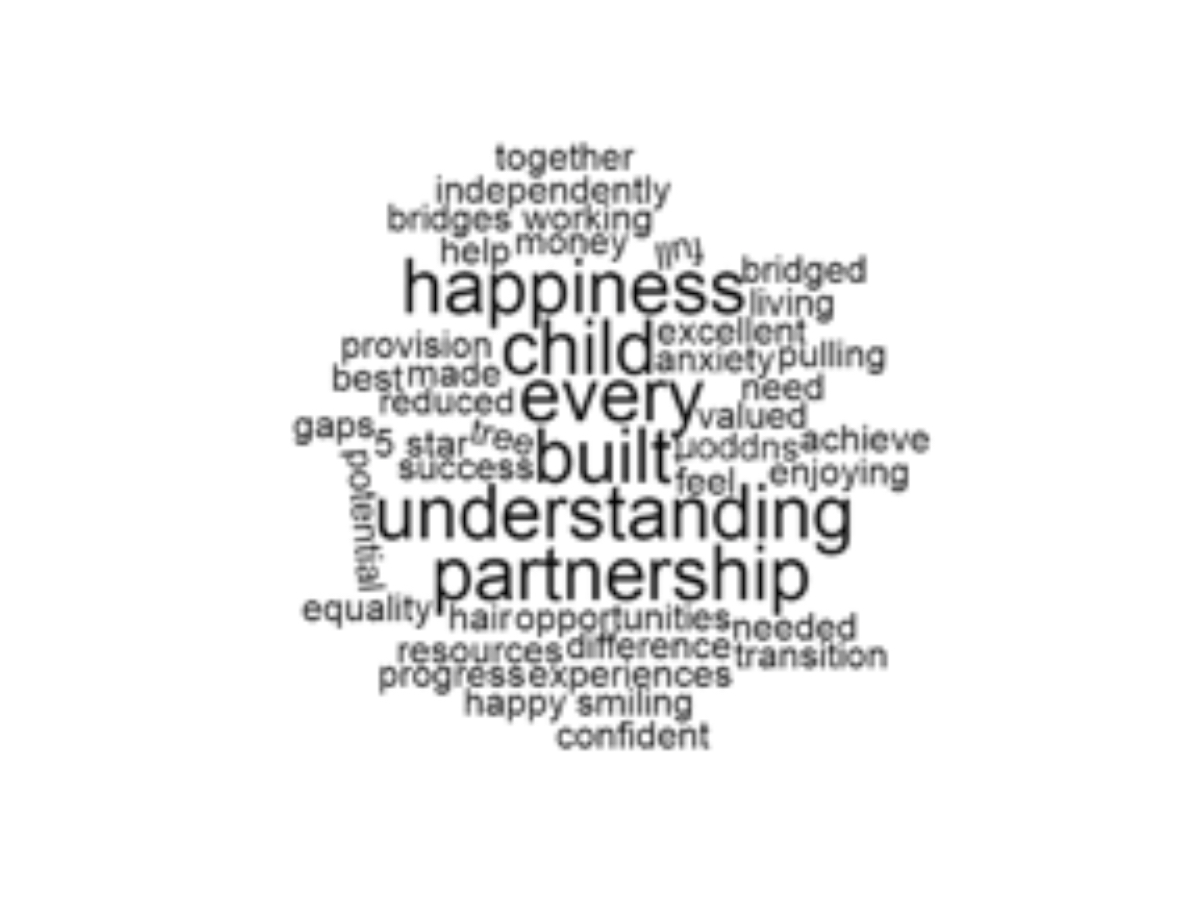
The word “understanding” is also used heavily across both teachers’ and parents’ groups. One teacher’s story illustrates how this group view themselves as a crucial part of a larger complex scenario:
“Gaps to be bridges. Bridges to be built. Built for all to achieve.”
Clinicians Exercise 3
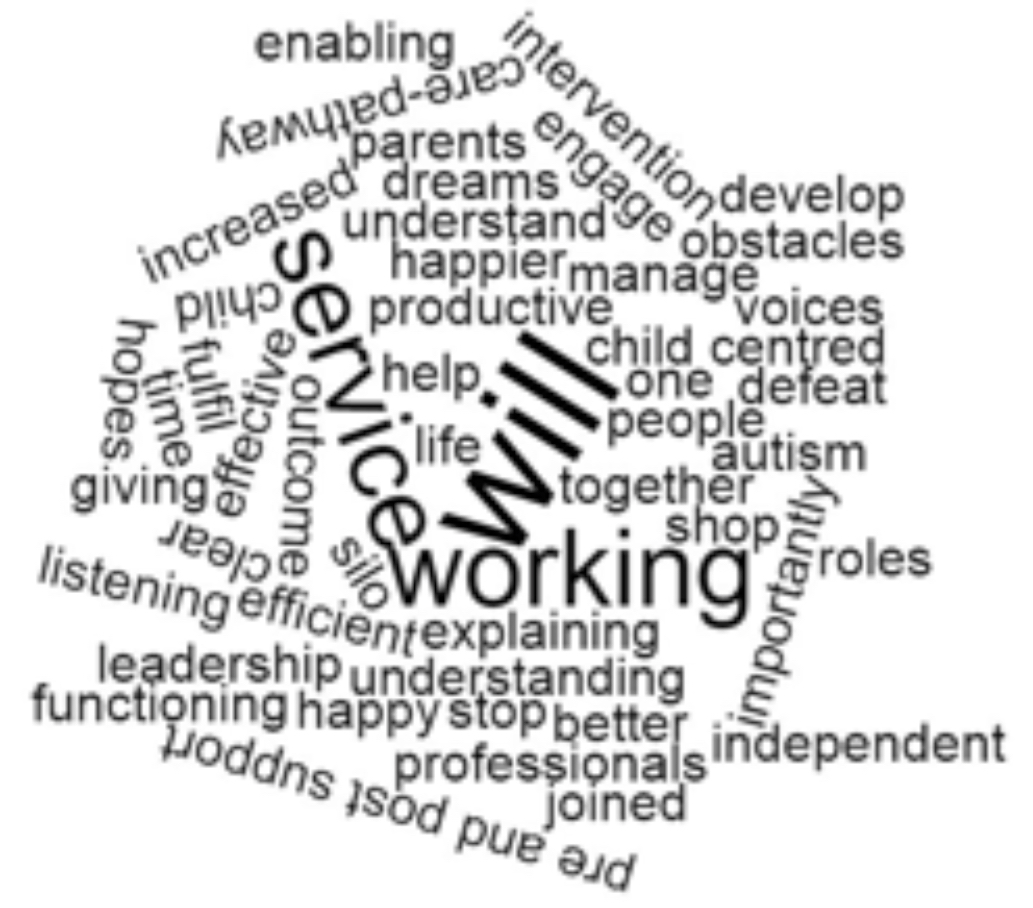
The clinicians’ clear end focus was on a “working” “service”, and while “parents”, “professionals” and “child” are mentioned, the greater emphasis is on a functioning process. This story from a clinician shows that, while the child is central to the story, the ideal ending is located in the success of the process:
“Working together. Child Centred. Better Outcome.”
Initial mathematical mapping of the language used in the creative writing exercises across all sessions highlighted some focal concerns across groups. The mathematician used R, a software environment for statistical computing and graphics, to analyze the creative responses across the three groups.
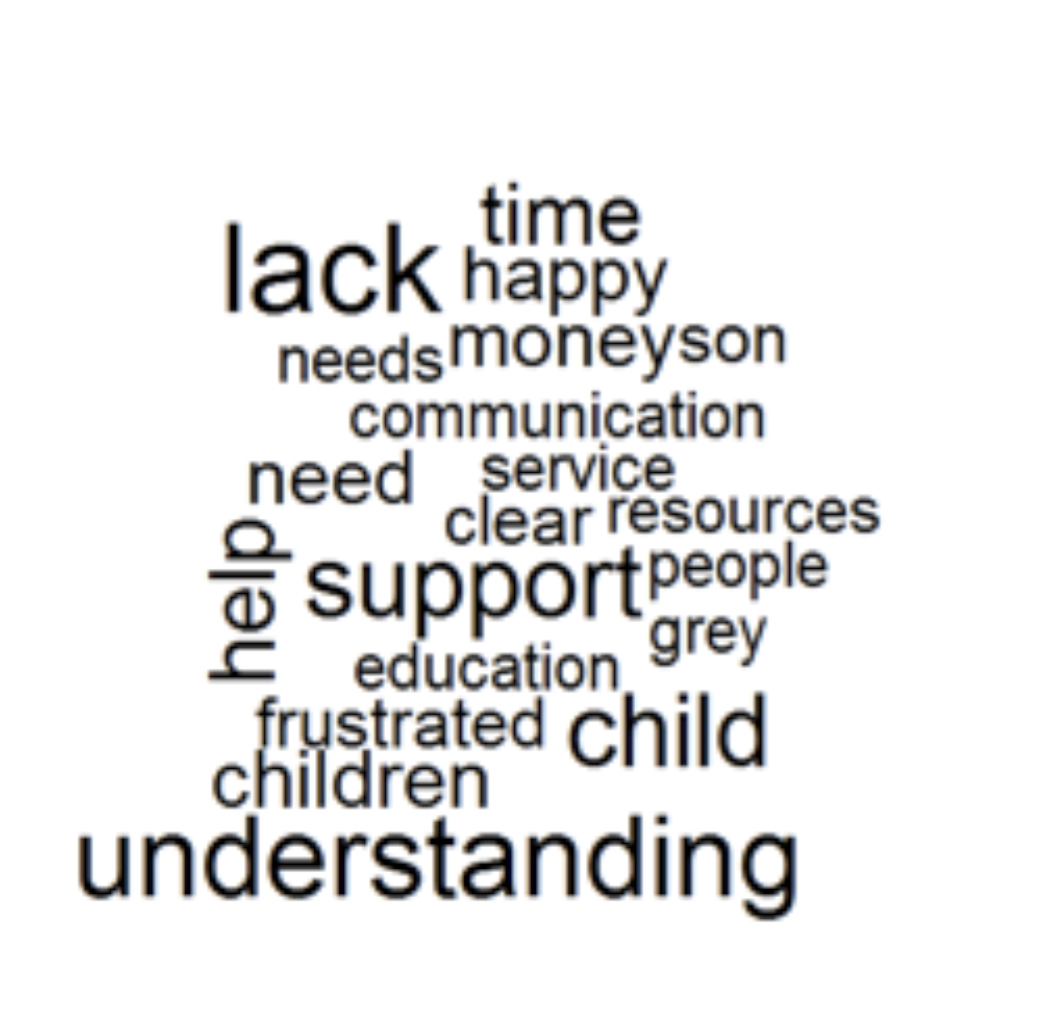
Findings were consistent in showing that participants had similar aims and goals but they used distinct lexicons within each group to describe the same thing. The most prominent words used by parents across all exercises were “understanding”, “son” and “happy”. (To repeat, “son” is being used as a representative word in place of specific children’s names.) The two most common words used by teachers were “money” and “time” and the clinicians’ most used words were “clear” and “service”.
One of the interesting points to emerge from the focus groups was the difference in the language used by the various groups. Again, this has been useful to feed back to the SAP review with regard to communication skills between agencies, highlighting that further work could be undertaken here, perhaps in relation to training for professionals.
When comparing the information generated from the focus group sessions to the creative writing produced through the exercises there is a considerable amount of difference as well as crossover. As the focus group discussions were lengthy, at over an hour each, the word cloud is not a suitable format for presentation and discussion of findings. The recordings of the focus groups have been transcribed and I have attempted a textual analysis.
In terms of the focus group discussions around the “typical”’ care pathways it was interesting to note a significant disjuncture between groups. For example, the parents’ group described their “typical”’ pathway as ending at diagnosis, whereas the educators and clinicians did not. Parents did not feel that care was offered nor delivered post diagnosis, yet professionals did. Outside of discussions around the “typical”’ pathway, conversation about personal experience, aspirations and needs saw issues emerge that resurfaced again later in the creative writing workshop. One major difference between the information generated by the focus group and the creative writing workshop was that the creative work demonstrated brevity whereas the focus group discussions were often long and circuitous. It seemed that the creative writing exercises enabled succinct and immediate description of the issues raised.
Feedback from parents suggested they valued the forum to talk and write about their experiences, with comments stating that it was “good to see parents finally being listened to.” They described it as an opportunity to explore their whole situation in a cohesive manner rather than a series of compartmentalized discussions to discrete professionals; for example, a discussion around diagnosis with a clinician or talking about learning support with a teacher. Most of the parents also expressed how useful it was for them to meet each other, since having a child with ASD can often feel like a lonely and isolating position. They expressed comfort in sharing experiences and used the occasion to share advice on securing support and facilities. Many participants also took the opportunity to exchange their contact details so that they could keep in touch beyond the sessions. Parents explained that, while they knew of each other (through their children who were friends in class, for example), they had not ever been introduced to each other. Some spoke about not wanting to approach one other at the school gate in case of causing offence in a public space. Others spoke about the fact that many children with ASD are provided with taxis for their journey to school, thereby making parents even less likely to meet each other and thus establish mutual support networks. The sessions appear to have been a swift and cost effective way of enabling parents to meet each other, share their experiences and exchange contact details if desired. A larger project or future studies could track the importance of establishing such potential networks in terms of ongoing parent and child support.
There was similar, positive feedback from the professional groups, with particular evidence of benefit to different staff members in reflecting upon their work. For example, when asked “What was good about participating in this project?” one speech therapist replied: “Teamwork. Sharing with colleagues. Exploring what we all do.” The teachers felt that the sessions had been beneficial in terms of the information that emerged. One teacher stated: “super, insightful discussion was generated.” It was clear that all groups generally felt that the sessions were a worthwhile and useful experience.
Conclusions
The creative responses produced emotionally engaging and concise personal expressions that we used to feedback to the WG about the SAP. I also feel that such creative responses could be used to educate and inform in a broader capacity, rather like the case study is used in medical education (Kendall & Murray 2005) but with increased brevity. This brevity helps the reader (Furman 2015), who may be less engaged with forms of writing they are overly familiar with in their professional life (reports, case studies, case notes etc.). It could be argued that it is easier to understand the experiences as poems or stories, rather than as clinical reports, educational reports or logistical maps. There is certainly more research to be conducted in this area through ACRe and beyond.
From this small-scale study it would seem that communication between stakeholders in ASD care is in need of support. As the WG SAP (2008: 3) states that effective cross-agency communication is necessary for good care provision, it is clear that a larger scale study could help identify specific barriers to communication. ACRe is currently conducting a thematic quantitative analysis of the focus group sessions in order to establish specific themes and issues for the focus of a larger scale study. The writing generated by the participant groups in this project will also be useful for stimulating discussion or debate in future studies.
Furthermore, the writing generated from this study could also be used in the training of clinical and educational professionals as engaging alternatives to the traditionally used case studies. In addition, it is possible that the writing generated could be used to raise awareness of the issues surrounding autism care. This was something that the parent group particularly wanted. A publication or website to display the writing would enable it to be shared across stakeholder groups. ACRe are currently considering the logistics of a number of possibilities and this is something that we hope to accomplish in the near future.
A larger study involving children with ASD as participants would certainly be a complex undertaking but it is evident that it would be worthwhile. While the information gathered in this study was informative, engaging and useful in a number of ways, it still does not reflect the concerns, opinions and experiences of children with ASD. In order to get a full appreciation of how care pathways are functioning it is obvious that we need to hear from those using the care pathways directly. Given that diagnosis and initial care often begins at primary school age, age appropriate exercises will need to be designed. As with the age of child participants, their positions on the spectrum will also impact upon their ability to participate in writing exercises. Further work needs to be done to consider whether child participants should or could be grouped according to age and/or level of literacy in any future writing workshops. In addition, while the initial study conducted by ACRe was in relation to care pathways that tend to be accessed from primary school age onwards, it is important not to ignore the issues around care for ASD adults. The work of the pilot study could certainly be used to develop suitable opportunities for ASD adults to participate in focus groups and writing workshops in order to express their experiences of care pathways. Again, complexities arise around identifying and organizing such participant groups in terms of literacy levels. ACRe is working to identify future research opportunities for working with children and adults with ASD.
My own appreciation of writing, as a method of discovery and analysis and as a process that results in the realization of a text, has not been altered in the course of this research but it has been enhanced. While I have much experience of running writing workshops with community groups (prisoners, carers, disadvantaged children) and in educational settings (FE, HE, secondary schools), I had not previously done so as part of a research project or in an interdisciplinary capacity. It was affirming to situate writing practice at the heart of a project looking to identify best practice and areas in need of support in order to enhance the delivery of clinical and educational service for children who need it. It underlined and enhanced my appreciation of how valuable writing practice can be in interdisciplinary research. The act of writing creatively can cut through the lexicons and silos that individuals and groups are placed in because of social, professional or personal reasons. Creative writing can be the practice that enables understanding, exploration, discovery and expression.
Acknowledgments
ACRe would like to thank all of the participants who took part in this research for their valuable input and generous commitment to the sessions.
I would also like to thank my fellow ACRe researchers for their collaboration in this research:
Dr Lisa Hurt (Principal Investigator, Cardiff University), Dr Jonathan Gillard (Cardiff University), Dr Kate Langley (Cardiff University), Dr Alex Southern (University of Wales Trinity St David) and Dr Sharon Williams (Swansea University)
References
Bryman, A. (2012) Social Research Methods. 4th Edition. Oxford: Oxford University Press.
Bury, M. (2001) Sociology of Health & Illness. 23 (3), 263-285.
Cofiño, R; Prieto, M; Suárez, O; Malecki, K. (2014) The Art of Drawing Numbers and Stories in the Air: epidemiology, information, emotion and action. Epidemiol Community Health. 68 (12), 1109-1111.
Charon, R. (2009) Narrative Medicine as Witness for the Self-Telling Body. Journal of Applied Communication Research. 37 (2), 118-131.
Charon, R. (2006) Narrative Medicine: Honoring the Stories of Illness. Oxford: Oxford University Press.
Charon, R; DasGupta, S. (2011) Narrative Medicine, or a Sense Story. Literature and Medicine. 29 (2), vii-xiii.
Denzin, N. K. (2014) ‘Writing and/as Analysis or Performing the World’ in U. Flick (ed.) The Sage Handbook of Qualitative Data Analysis. London: Sage Publications Ltd.
Furman, R. (2015) Autoethnographic Explorations of Researching Older Expatriate Men: Magnifying Emotion Using the Research Pantoum. Creative Approaches to Research. 8 (3), 102-114.
Greenhalgh, T; Hurwitz, B. (1999) Narrative Based Medicine: Why study narrative? British Medical Journal. 318. 48-50.
Haglund, D. (2013) Did Hemmingway Really Write His Famous Six Word Story? [online]. (January 31). Slate. Available here: [Accessed 29 April 2016].
Health and Social Services & Children, Education, Lifelong Learning and Skills (2008) ASD Strategic Action Plan. (Edwina Hart AM MBE, Jane Hutt AM). Cardiff: WG.
Hirschfield, J. (2008) Hiddenness, Uncertainty, Surprise: Three Generative Energies of Poetry. Tarset, Bloodaxe Books Ltd.
Huyssen, A. (1986) After The Great Divide: Modernism, Mass Culture, Postmodernism. Bloomington: Indiana UP.
Kendall, M; Murray, S.A. (2005) Tales of the Unexpected: Patients’ Poetic Accounts of the Journey to a Diagnosis of Lung Cancer: A Prospective Serial Qualitative Interview Study, Qualitative Inquiry. 11 (5), 733-751.
Kroll, J. & Harper, G. (2013) Research Methods in Creative Writing. Basingstoke: Macmillan.
McCulliss, D. (2013) Poetic Inquiry and Multidisciplinary Qualitative Research. Journal of Poetry Therapy. 26 (2), 83-114.
Peterkin, A. (2011) Primium Non Nocere: On Accountability in Narrative-Based Medicine. Literature and Medicine. 29 (2), 394-411.
Propp, V. Y. (1969) Morphology of the Folk Tale. Austin: University of Texas Press.
Rapport, F; Harthill, G. (2010) Poetics of Memory: in defense of literary experimentation with Holocaust survivor testimony. Anthropology and Humanism. 35 (1), 20-37.
Rapport, F; Harthill, G. (2012) Crossing Disciplines with Ethnographic Poetic Representation. Creative Approaches to Research. 5 (2), 11-25.
Kate North is from Cardiff. She writes poetry and fiction. Her novel, Eva Shell, was published in 2008 and her poetry collection, Bistro, in 2012. She teaches Creative Writing at Cardiff Metropolitan University. www.katenorth.co.uk